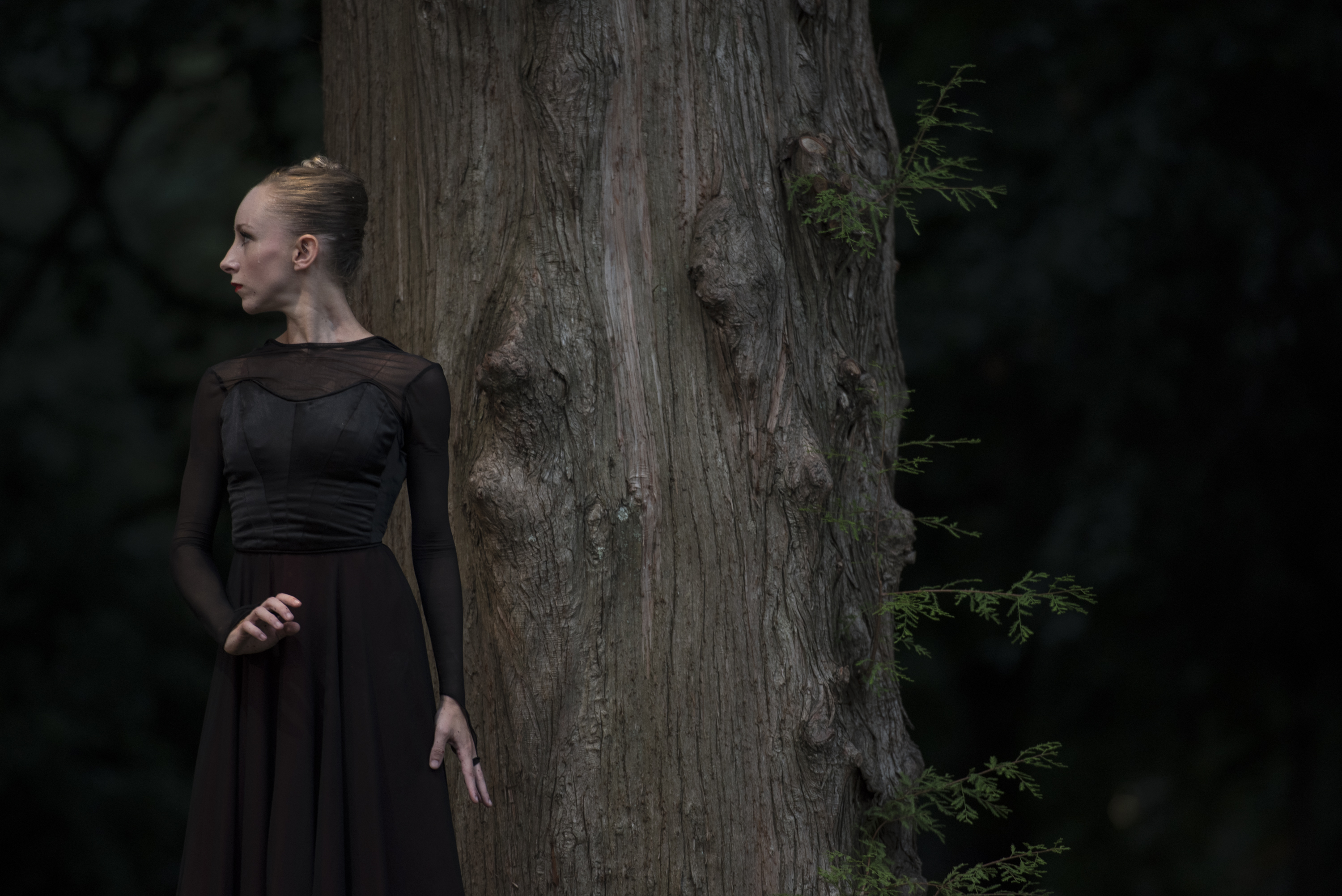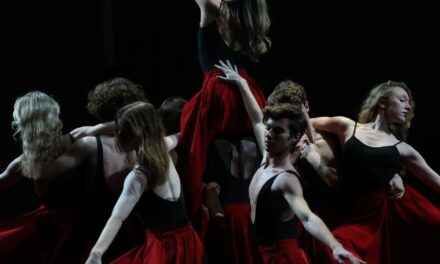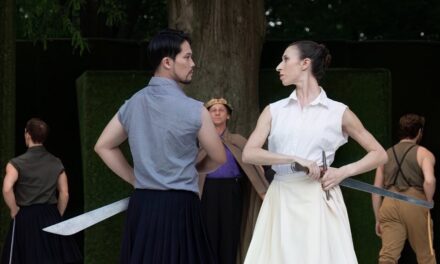Lexa Daniels in Lady Lear. Photo courtesy the Louisville Ballet.
Lady Lear
Choreography by Roger Creel
Score by Scott Moore
Review by Kathi E.B. Ellis
Entire contents copyright © 2017 Kathi E. B. Ellis. All rights reserved.
This week sees the closing of Kentucky Shakespeare’s 57th season of free, continuous, outdoor Shakespeare productions, making it the oldest company of its kind in the country. To mark the second and final Community Partner Week, they are teaming up with the Louisville Ballet, one of the oldest ballet companies in the country – a fine pairing.
Following on from last summer’s first Ballet in the Park, choreographer Roger Creel continues his exploration of Shakespeare through movement and dance. Last season it was an exploration of the love triangle in the sonnets, Will’s Folly, this time he tackles one of Shakespeare’s late, great plays, King Lear. Once again his music collaborator is Scott Moore, who has created a suite of music for the ballet.
I come to this experience both as a balletomane and as a lover of Shakespeare – both curious and cautious of how the cross-genre exploration will go – while recognizing that in that crossover some things get left out and others amplified.
Creel has stated that he wants to examine the Lear/daughters dynamic with Lear as queen – a nod to both there being relatively few women’s characters in Shakespeare’s canon and that significant ballet roles reduce the older a female dancer gets – with three sons among whom she wishes to divide the kingdom. And his choice follows not only in a long tradition of women playing Shakespearean men but also obliquely catches the current trend for staging his plays with all the characters of one gender.
Creel makes some smart choices in streamlining the storylines: gone are the spouses of the progeny, as are some of the smaller roles. Gone is the subplot of those other two sons, Gloucester’s Edgar and the illegitimate Edmund, as is the courtier Gloucester himself. More problematic, in terms of balancing the forces of good and evil, is the conflation of Gloucester and Kent (originally a loyal courtier to Lear and here demoted to housekeeper) in the character of Kentster. It is she who has the two daughters, one of whom, arguably, also stands in for the Fool character– otherwise this most important symbol of Lear’s ultimate capacity for humanity is excised too. Without the anchor of the noble Edgar, the character of Poor Tom (originally Edgar’s disguise during his self-imposed exile) is unmoored from the larger theme of self-recognition or its absence.
Pared down to eight characters, we are ready for a streamlined Lady Lear, with characters identified in the playbill by essential traits that suggest characters will be treated more emblematically than as fully-rounded characters.
In this streamlined world, I would have rather the ballet begin with the courtroom scene in which Lady Lear attempts to divide her kingdom. Significantly longer than Shakespeare’s initial scene, the first-scene introduction of Kentster (half-heartedly sweeping, which almost swept me to a completely different myth…) and her daughters Eunice and Fanny quickly became repetitive; and even with the arrival of Lear, I found it difficult to imagine that such an arrogant and self-absorbed Lady would tolerate the girls’ hi-jinks.
Once in the courtroom scene we are in familiar territory as Lear (Kateryna Sellars) forcefully demonstrates the way she intends to divide her territory, conjuring up gesture that ground us in the mid-twentieth century dance drama tradition. The oldest two sons Goneril (John Brewer) and Regan (Ryan Stokes) profess their undying love and fealty in sequences that are both virile and obsequious, clearly competing with each other for their mother’s approval. To no avail, Lear demands to hear from Cornelius (Brandon Ragland.) Simply, he embodies the bond between them, she returns the gesture, and he then dances a short, understated sequence of his love for her. The brief lyric pas de deux between Lear and Cornelius quickly gives way to an ensemble sequence in which the court, almost mechanistically, separates these two characters. Thereafter Cornelius is banished and Lear divides the land between Goneril and Regan.
Taking full advantage of the breadth of the Central Park stage, the respective houses of the two sons are placed on each flange of the stage, providing ample space for Lady Lear’s travels between the two in her ‘retirement.’ Also dividing her time between the two boys is Eunice (Jordan Martin) who has escalated from mean teasing of her sister to seducing both of the sons to do her bidding, in this way echoing part of the function of the original Edmund. In this version, Eunice is also the instigator of her mother’s death as Kentster (Lexa Daniels) tries to protect Lear, a task that thus falls to Fanny/Fool (Annie Honebrink.)
Lear’s breakdown is also staged mechanistically, there are many angular and abrupt steps and movements that suggest a bodily disconnect. In one of the sequences on the heath it almost appears that she is a puppet whose strings keep giving way, with Fanny trying to uphold her. During these sections both movement and music are constrained, staccato, there is little sense that the mind or the heart are affected by the betrayal and casting out that Lear has experienced. Even if the ‘madness’ of the original Lear is not being evoked, this cool approach robs performer and audience alike of entering into her disaffect.
It is not until Cornelius and Lear are reunited at the end that space is made for a human connection, as the two echo part of their act one duet, with the frailty of Lear cruelly reminding us of how far she has traveled from being a monarch. Indeed, these two sequences could mirror each other even more, with some of the non-traditional lifts that this company can do so well, with Lear even more visually in control in act one, paving the way for the tenderness of Cornelius cradling Lear in act two.
Poor Tom (Leigh Anne Albrechta) is the other opportunity for humanity, and Albrechta certainly has some of the more lyrical choreography in the piece and is clothed in a reassuring blue. This role, somewhat blunted as mentioned hitherto, is also made confusing by the swathes of tulle that is part of the costume. Is Tom real or not? Certainly a question raised in the original, but there the answer comes fully embodied in a character in disguise. Here, there is a suggestion of guardian spirit in the final moment of the ballet, and yet Tom also takes up very human arms to protect Lear and kill those who would kill her.
Another occurrence of realism and abstractedness jibbing awkwardly is the characterization of the storm. The young ensemble wields umbrellas in a style that is more reminiscent of musical theatre than psychodrama. This sequence is set against some interesting scoring of rain sticks and percussion that contradicts the very real umbrellas.
Sellars is, as she so well can be, magnificently regal and powerful. I could have wished for her to have the opportunity for more range in Lear’s downfall. Brewer and Stokes admirably fulfill their stock characters, as do Martin and Honebrink. Other than the extended fight sequences (created by Sarah Flanagan) that Daniels executed effectively, the Kenster role is underwhelming. Ragland continues to demonstrate a sympathetic partnering style. Albrechta radiates the goodness of Poor Tom.
Choreographer Creel tackled complex source material for his Lady Lear. Seeing it at its premiere I felt like there is more to be done, that what we were viewing was still a draft. Creel is a choreographer with lots of ideas that he embraces energetically; I’d like to see him embrace the heart of his ideas just as enthusiastically. He does neither himself nor Shakespeare much benefit if these robustly conceived characters are to become a collection of character traits.
Even in a pared down playbill, it would have been helpful to list the design credits. Frequently at this point in the season, design opportunities are given to Kentucky Shakespeare interns. If that is the case it would be good to give these artists-in-training credit, and equally so if Ballet staff or other local designers were involved. And making sure credit goes all the way around, the opening night’s preshow was a delightfully heartfelt dance exhibition by the Louisville Downs Syndrome’s youth dance troop.
Both companies announced their seasons this week. Whether it is Shakespeare or dance you like, be sure to check out their offerings during 2017-2018!
Lady Lear
August 9-13 2017 @ 8:00pm
Louisville Ballet
C. Douglas Ramey Amphitheatre
Central Park
Louisville , KY 40202
FREE ADMISSION
Kathi E.B. Ellis is an associate member of the Stage Directors and Choreographers Society and a member of Lincoln Center and DirectorsLabChicago. She has attended the La MaMa Directing Symposium in Umbria, Italy and is featured in Southern Artisty, an online registry of outstanding southern artists. Her directing work has been recognized with nominations for South Florida theatre’s Carbonell Award. Locally, Kathi is a member of Looking for Lilith Theatre Company, a founding principal of StageLab theatre training studio, and part of ShoeString Productions, an informal producing collective. She has written book reviews and articles for Southern Theatre, the quarterly publication of the Southeastern Theatre Conference, and was a contributing writer for JCPS’ textbook for the 11th grade Arts and Humanities survey course and for YouthArts Tapestry, a Kentucky Arts Council publication.





